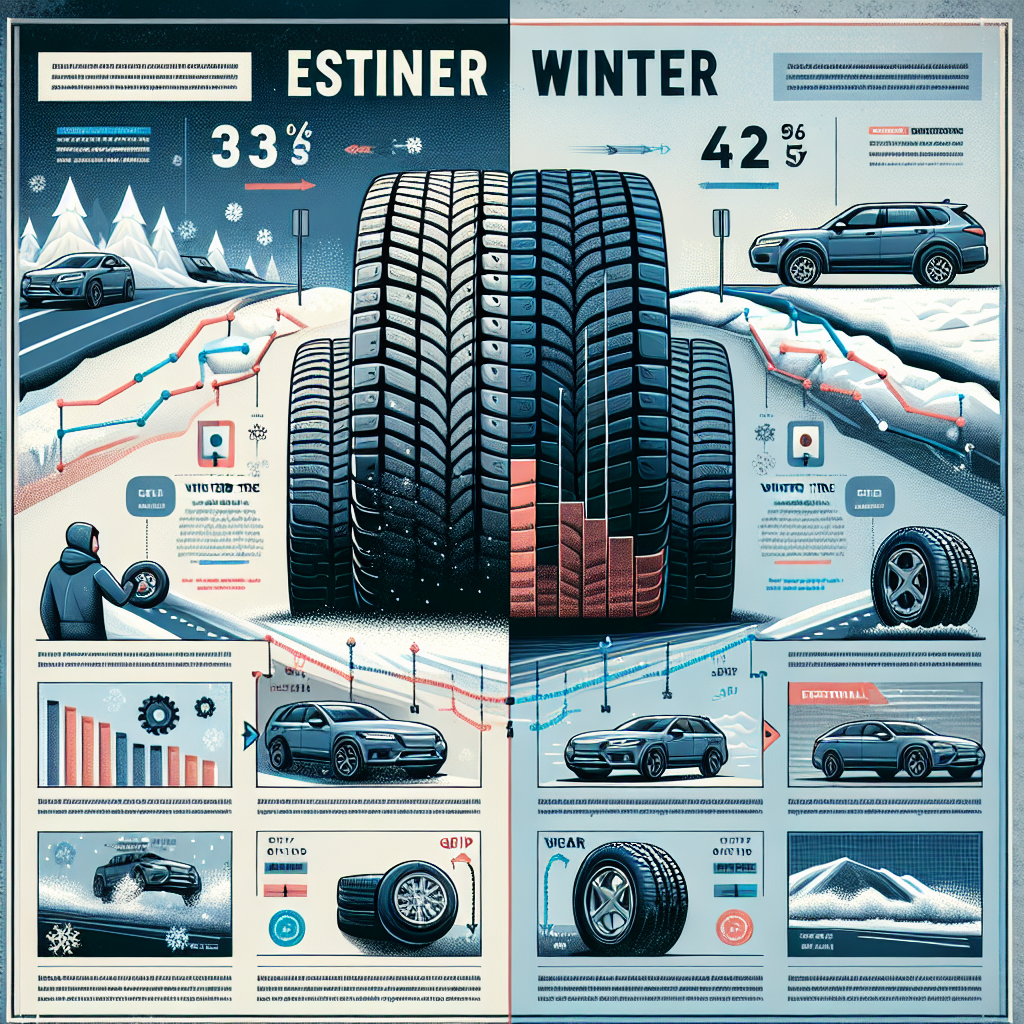Have you ever wondered how winter tires perform on dry roads and in warmer temperatures? Many people assume that winter tires are only suitable for cold and snowy conditions, but the truth is they can still be beneficial even on dry and warmer roads. While winter tires are specifically designed to excel in icy and snowy conditions, they also have some unique characteristics that can provide better traction and handling, even when the temperature rises. In this article, we will explore how winter tires adapt to different road conditions and temperatures, and why they are still worth considering even when winter is over.

Can winter tires be used on dry roads and warmer temperatures?
Understanding the purpose of winter tires
Winter tires are specifically designed to provide enhanced traction and grip in cold weather conditions, including snow, ice, and slush. They are constructed using unique tread patterns, softer rubber compounds, and other design features that enable them to perform optimally in winter conditions. However, their performance on dry roads and warmer temperatures may be different than when used in their intended environment.
Potential issues with using winter tires on dry roads and warmer temperatures
While winter tires excel in cold weather conditions, they may encounter certain challenges when used on dry roads and in warmer temperatures. One of the main concerns is accelerated tread wear, as the softer rubber compounds of winter tires tend to wear down more quickly on dry surfaces. This can reduce their overall lifespan and require more frequent tire replacements. Additionally, winter tires may not provide the same level of handling, responsiveness, and fuel efficiency on dry roads as all-season or summer tires.
The impact of dry roads and warmer temperatures on winter tire performance
Dry roads and warmer temperatures can significantly affect the performance of winter tires. The unique tread patterns of winter tires, designed to provide traction on snow and ice, may not perform optimally on dry surfaces. The softer rubber compounds can also result in reduced grip and increased rolling resistance, impacting both braking and handling performance. Furthermore, the stiffer sidewalls of winter tires, which contribute to stability on snow, may affect the ride comfort and noise levels on dry roads.
Construction and design of winter tires
Unique tread patterns for winter conditions
Winter tires feature tread patterns with specially designed grooves and sipes that enhance their performance on snow and ice. These grooves help to evacuate water and slush from the tire’s contact patch, reducing the risk of hydroplaning and improving overall traction. However, on dry roads, these same tread patterns may result in decreased contact area, leading to reduced grip and handling capabilities.
Softer rubber compounds for improved grip
Winter tires utilize softer rubber compounds to maintain flexibility in cold temperatures, maximizing grip on slippery surfaces. These compounds are designed to remain pliable and provide better traction in freezing conditions. However, on dry roads and warmer temperatures, the soft rubber can wear down more quickly and may not offer the same level of grip as firmer compounds found in all-season or summer tires.
Sipes and grooves for enhanced traction
Sipes, which are the small slits or cuts in the tread blocks of winter tires, help to provide additional biting edges and improve traction on snow and ice. The design and depth of siping on winter tires are optimized for winter conditions. However, on dry roads, excessive siping may result in reduced tire-to-road contact, impacting grip and handling performance.
Stiffer sidewalls for better stability
Winter tires generally feature stiffer sidewalls compared to all-season or summer tires. This sidewall stiffness helps to maintain stability and responsiveness in winter conditions. However, on dry roads, the stiffer sidewalls may result in a harsher ride and increased road noise.
Effects of these design features on dry road performance
While the construction and design features of winter tires are essential for their performance in cold weather conditions, they may have drawbacks when used on dry roads and in warmer temperatures. The unique tread patterns, softer compounds, sipes, and stiffer sidewalls can all impact the tire’s grip, handling, comfort, and noise levels. It is important for drivers to consider these factors and adjust their expectations accordingly.
Tread wear and longevity
Accelerated tread wear on dry roads
One of the main concerns with using winter tires on dry roads is accelerated tread wear. The softer rubber compounds that provide excellent grip in cold temperatures wear down more quickly on dry surfaces. The lack of snow and ice makes the softer rubber prone to rapid degradation, resulting in a reduced lifespan of the tire. Regular inspection and monitoring of tire tread depth are crucial to ensure optimal performance and safety.
How warmer temperatures affect tire life
Warmer temperatures can also have a detrimental effect on a winter tire’s lifespan. The heat generated by increased friction on dry roads can cause the rubber to deteriorate more rapidly. As the tire’s compound becomes less pliable, it loses its ability to grip the road effectively. This can lead to decreased performance and safety concerns. It is vital to keep track of temperature changes and, when necessary, transition to tires more suitable for warmer conditions.
Balancing tread wear and road grip
Finding the right balance between tread wear and road grip is crucial when using winter tires on dry roads. While it is essential to prolong the life of the tire, compromising grip and safety is not recommended. Regular rotation of the tires can help promote even wear and extend their lifespan. Monitoring tire pressure and maintaining proper inflation levels are also important factors in optimizing tread wear and preserving performance.
Rotating tires for prolonged usability
Rotating tires at regular intervals can help evenly distribute wear and extend their usability. This practice is especially important when using winter tires on dry roads, as certain areas of the tire may experience faster wear than others. By rotating the tires, you can promote more uniform tread wear and improve their overall longevity. It is advisable to follow the manufacturer’s recommendations regarding tire rotation intervals to maximize the lifespan of your tires.
Braking and handling performance on dry roads
Reduced braking distances compared to all-season tires
Winter tires are designed to offer shorter braking distances on slippery surfaces due to their superior grip and enhanced traction. However, on dry roads, the softer rubber compounds of winter tires may not provide the same level of grip as all-season tires, resulting in longer braking distances. It is important to adjust your driving style and anticipate longer stopping distances when using winter tires in dry road conditions.
Cornering and maneuverability at higher temperatures
While winter tires excel in providing stability and control in cold weather, their performance may be compromised on dry roads and in warmer temperatures. The unique design features, such as the tread patterns and softer rubber compounds, may cause reduced responsiveness and maneuverability when cornering. Drivers should be cautious and adapt their driving style accordingly to compensate for any limitations in handling performance.
Factors affecting grip and responsiveness
Several factors can influence the grip and responsiveness of winter tires on dry roads. The softer rubber compounds can result in a decrease in grip, especially as temperatures rise. The unique tread patterns, although effective in winter conditions, may not provide optimal contact with the road surface on dry roads. It is important to be aware of these factors and adjust your driving style accordingly to ensure safe and controlled handling.
Potential limitations in dry road performance
Winter tires are purpose-built for cold weather conditions, and their performance may be compromised on dry roads and in warmer temperatures. The unique design and characteristics that make these tires excel in snow and ice can result in decreased performance when used in unsuitable conditions. While they may still offer superior grip compared to all-season or summer tires, drivers should be mindful of any limitations and adjust their expectations accordingly.

Fuel efficiency and rolling resistance
Winter tire tread and its impact on fuel consumption
The design of winter tire treads, specifically the deeper grooves and sipes, can contribute to increased rolling resistance and therefore affect fuel efficiency. The added tread depth and aggressive patterns are necessary for snow and ice traction but create additional friction when used on dry roads. Consequently, this can lead to higher fuel consumption compared to tires with a shallower and less aggressive tread design.
Effect of warmer temperatures on rolling resistance
Warmer temperatures can exacerbate the impact of winter tire tread on rolling resistance. The combination of the softer rubber compounds and the increased heat generated on dry roads leads to higher levels of friction, resulting in further decreased fuel efficiency. It is important to consider the potential trade-off between the enhanced performance of winter tires in cold conditions and their impact on fuel consumption in warmer temperatures.
Balancing fuel efficiency and winter tire benefits
Finding a balance between fuel efficiency and the benefits provided by winter tires is important when using them on dry roads. While winter tires may result in slightly increased fuel consumption due to their design, they still offer superior traction and safety in cold weather. Drivers should weigh the benefits of increased grip and performance against the potential decrease in fuel efficiency to ensure they make an informed decision based on specific needs and driving conditions.
Noise and comfort levels
Winter tire noise characteristics on dry roads
Winter tires often produce more noise on dry roads compared to all-season or summer tires. The unique tread patterns, including the aggressive grooves and sipes, can generate more noise as the tires interact with the road surface. This noise can be noticeable, particularly at higher speeds. However, advancements in tire technology have led to improved designs that aim to reduce noise levels while maintaining optimal performance.
The influence of temperature on tire noise
Temperature can also influence tire noise levels. In colder temperatures, the rubber compounds of winter tires can become stiffer, potentially leading to increased noise. Conversely, warmer temperatures can make the rubber more pliable, which may lead to slightly reduced noise levels. It is important to be aware of these temperature-related variations and adjust your expectations accordingly to ensure a comfortable and enjoyable driving experience.
Balancing noise reduction and winter performance
Tire manufacturers continually strive to strike a balance between noise reduction and winter performance. While advancements have been made to mitigate noise levels, it is important to consider that the design features necessary to provide enhanced traction in winter conditions may result in slightly increased noise on dry roads. Drivers should assess their priorities and determine the level of noise reduction they are willing to sacrifice in favor of improved winter performance.

Maintaining and storing winter tires
Inspecting tires for wear and damage
Regular inspection of winter tires is crucial to ensure their optimal performance and longevity. Check the tires for signs of wear, such as tread depth, uneven wear patterns, and any visible damage like cuts or bulges. It is recommended to inspect the tires before the winter season begins and periodically throughout its duration to address any potential issues promptly. This will help maintain the safety and effectiveness of the tires, regardless of the road conditions.
Proper cleaning and storage techniques
When transitioning from winter to all-season or summer tires, proper cleaning and storage are important to preserve the condition of the winter tires. Thoroughly clean the tires to remove any dirt, salt, or debris that may have accumulated. Store the tires in a cool, dry, and dark location, preferably on racks or tire stands to prevent distortion. Properly maintaining and storing winter tires will ensure they are ready for use in the next winter season.
When to switch back to all-season or summer tires
Knowing when to switch back to all-season or summer tires depends on the prevailing weather conditions in your region. As a general guideline, it is advisable to switch to all-season or summer tires once the temperatures remain consistently above 7°C (45°F). This temperature range indicates that winter conditions, for which winter tires are specifically designed, are no longer present. It is important to make this transition in a timely manner to maintain optimal performance, grip, and fuel efficiency.
Comparing winter tires to all-season and summer tires
Differences in performance characteristics
Winter tires, all-season tires, and summer tires are designed to cater to specific weather conditions and performance requirements. While winter tires excel in cold weather and snow, all-season tires offer a balance between different seasons, and summer tires prioritize warm and dry conditions. Winter tires generally provide the best grip and traction in winter conditions, while all-season and summer tires may offer superior performance on dry roads and in warmer temperatures.
Benefits and drawbacks of each tire type
Winter tires provide unmatched traction in cold weather and snowy conditions, making them essential for regions with severe winters. However, they may have limitations on dry roads and in higher temperatures, including reduced grip, faster tread wear, and decreased fuel efficiency. All-season tires offer versatility and moderate performance in various weather conditions, while summer tires provide excellent grip, responsiveness, and handling in warm weather. It is crucial to consider the benefits and drawbacks of each tire type when choosing the most suitable option for specific driving conditions.
Making the right tire choice for specific conditions
Choosing the right tire type for specific conditions involves considering factors such as climate, driving habits, average temperatures, and road conditions. If you frequently encounter severe winters with snow and ice, winter tires are highly recommended to ensure optimal safety and performance. In regions with milder winters and a mix of weather conditions, all-season tires may be suitable to provide year-round reliability. Summer tires are best suited for areas with consistently warm temperatures and dry road conditions. Careful evaluation of these factors will help you make an informed decision and select the most appropriate tire type for your needs.

Safety considerations
Importance of adjusting driving style to conditions
Regardless of the tire type, adjusting your driving style to match the prevailing road conditions is essential for safety. Winter tires are specifically designed for improved traction in cold weather, but they cannot guarantee invincibility on dry roads or in warmer temperatures. It is crucial to drive cautiously, maintain appropriate speeds, and allow for longer braking distances when using winter tires in unsuitable conditions. Remember that tires are a vital component of safe driving, but driver behavior and adapting to the environment are equally important.
Winter tire safety in dry road scenarios
While winter tires may have limitations on dry roads, they can still offer better traction and grip compared to all-season or summer tires. The tread patterns, softer compounds, and design features of winter tires contribute to their overall safety performance. However, drivers should be mindful of their reduced responsiveness and adjust their expectations accordingly. It is essential to assess the specific road conditions and make informed driving decisions to ensure safety while using winter tires on dry roads.
Avoiding overconfidence in winter tire capabilities
One potential danger of using winter tires on dry roads and in warmer temperatures is overconfidence in their capabilities. While these tires may provide enhanced traction in winter conditions, their performance may be compromised on dry surfaces. It is crucial to avoid overestimating the grip and handling abilities of winter tires and adjust your driving style accordingly. Maintaining vigilance, avoiding abrupt maneuvers, and driving defensively will help prevent accidents and ensure a safe driving experience.
Legal regulations and requirements
Mandatory use of winter tires in certain regions
In some regions with severe winters, the use of winter tires or tires with specific winter performance ratings may be mandatory by law during designated periods. These regulations are intended to enhance road safety and prevent accidents during adverse weather conditions. It is essential to familiarize yourself with your local laws and requirements regarding winter tire usage to ensure compliance and maintain safety on the roads.
Understanding local regulations on tire usage
Beyond mandatory winter tire usage, there may be additional regulations and requirements concerning tire usage in your specific region. These regulations may cover aspects such as minimum tread depth, specific tire ratings, and other safety-related requirements. It is important to research and understand these regulations to ensure compliance and promote road safety. Consulting with local authorities, tire experts, or reviewing official publications can provide valuable information regarding these regulations.
Potential legal implications of using winter tires in unsuitable conditions
Using winter tires on dry roads and in warmer temperatures may have legal implications in regions where specific tire requirements are enforced. While winter tires may offer enhanced performance in winter conditions, they may not meet legal requirements outside of their intended environment. Violating local regulations related to tire usage can result in fines, penalties, and potential liabilities in the event of accidents. Drivers should ensure they comply with applicable laws and use tires suitable for the prevailing conditions to avoid legal consequences.


